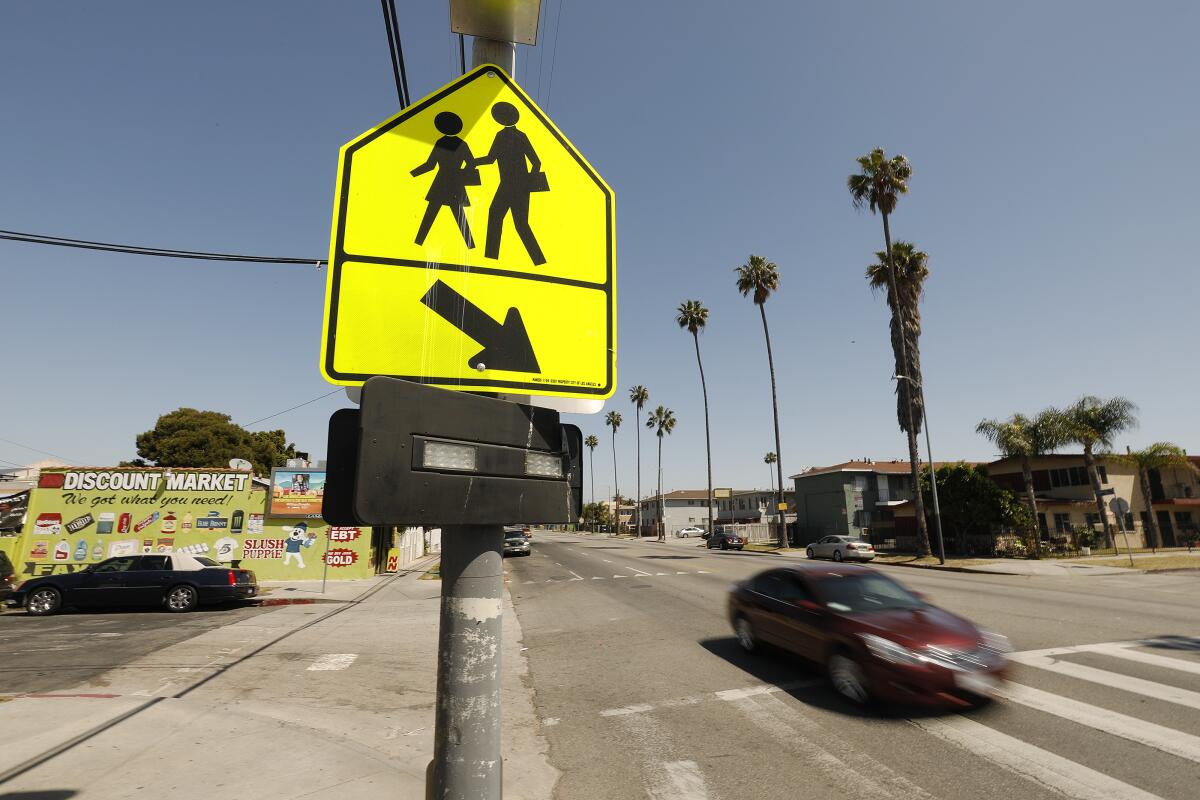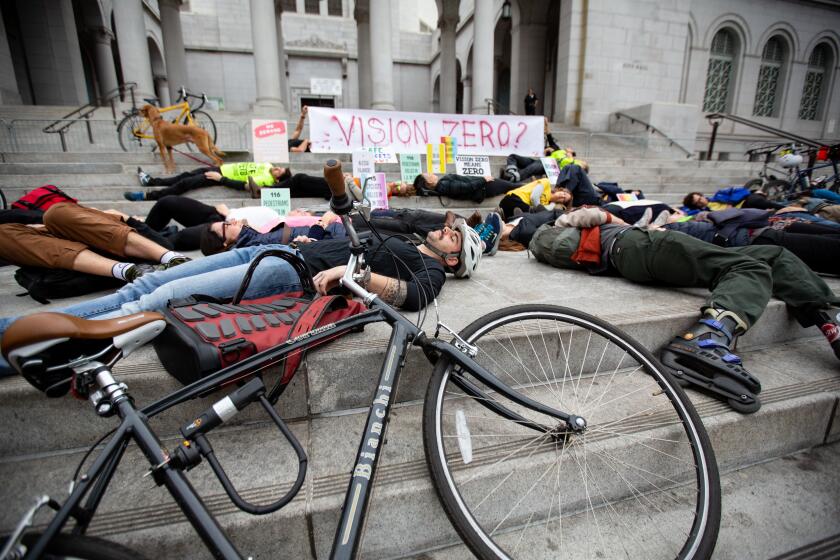Column: Eliminating all traffic deaths is a worthy goal. Impossible, but worthy

- Share via
When we talk about traffic in this car-dependent part of the world, we usually gripe about the amount of time it takes to get from Point A to Point B.
This is why the early days of the pandemic had a certain paradoxical charm.
In our terror, we holed up. But if we did have to drive somewhere, oh, what a pleasure it was to be on those suddenly empty roads. And it seemed obvious that with fewer vehicles on the road, there would surely be fewer collisions, fewer injuries and fewer deaths. Right?
Strangely, no.
As my colleague Dakota Smith reported last month, traffic deaths and injuries in Los Angeles did not drop last year, they rose. Pedestrians were especially at risk for severe injury or death. And in 2020, the toll was only slightly better.
This is especially ironic, because in 2015, Los Angeles Mayor Eric Garcetti announced an initiative to eliminate all traffic deaths by 2025. The plan wasn’t original; Vision Zero is an idea out of Sweden that has caught on in cities all over the world. It’s based on reducing traffic deaths and injuries by improving street design and lowering speed limits, among other things.
Last month, in response to a nationwide increase in traffic deaths, Transportation Secretary Pete Buttigieg unveiled a similar goal for the nation. He called for new federal road design rules, changing how speed limits are set (which California has already done) and making vehicles safer by possibly requiring automatic brake technology.
The goal is worthy, but why go out on a limb with a big, bold promise that is so obviously doomed to fail?
In Australia, at least, they call the effort “Toward Zero,” which seems more realistic.
“There is a risk we run of saying, oh, OK, we are committed to Vision Zero but we are not making progress yet,” said Leah Shahum, the founder and director of the Vision Zero Network, which advocates for transportation safety. “But even saying this is possible, and we are going to change business as usual is important. Will practices, policies and funding decisions stop on a dime and look different tomorrow? Of course not.”
Traffic deaths climbed again in Los Angeles in 2021, raising doubts about Mayor Eric Garcetti’s program to end such fatalities by 2025.
Shahum said that in Europe, which had lockdowns and less traffic on roadways too, there was a corresponding drop in traffic deaths. Why not here?
American roads are built differently, and our cars tend to be big and heavy. “The bigger the vehicle,” she said, “the dramatically more dangerous.” And while the interiors of our cars have become safer for drivers and occupants, we have shifted the danger outside the car, to pedestrians, which helps explain the spike in pedestrian deaths.
As long as there is traffic, there will be traffic tragedy, especially in a car-centric city like ours, where you cannot drive an inch without seeing distracted drivers holding phones. How many times have you been stuck behind a car at a red light that doesn’t move when the light turns green because the driver in front is poking at a screen? At least while they aren’t moving, they aren’t killing anyone.
Officials theorize that the rise in traffic deaths is partly related to the same pandemic forces you’d think would make us safer: With so many fewer cars on the road, drivers got a little speed crazy. I’m sure that’s true. But I also think a global pandemic can inspire a sense of fatalism. I mean, if we’re all going to die of COVID, why bother buckling up?
To the editor: The Times fails its readers with its sophomoric characterization and reductive understanding of the issue and the people affected.
I did not realize until John Yi pointed it out that Los Angeles County also has its own Vision Zero plan, and has vowed to end all traffic death by 2035, 10 years after the deadline set for the city by Garcetti.
“Our roads are all connected and don’t look at boundaries,” said Yi, executive director of Los Angeles Walks. His group works to make the city safer for walkers, particularly in low-income neighborhoods, which have a disproportionate number of pedestrian deaths and injuries.
“We have no comprehensive vision of what movement looks like in L.A.,” he added. “Each council member can apply Vision Zero their own way in their own district, so there are 15 different approaches and policies.”
Indeed, in 2017, Councilman Mike Bonin, whose district includes Pacific Palisades, Venice and Westchester, narrowed traffic lanes in Playa del Rey to force cars to slow down and make the road safer for bicycles and pedestrians.
Traffic definitely slowed down. In fact, the ensuing traffic jams so enraged constituents that they started an effort to recall him. The recall fizzled after the traffic lanes were restored.
To the editor: Motorists naturally complain when lanes dedicated for their near-exclusive use are replaced with bike lanes and other changes are made to improve safety.
“That caused a shiver in elected officials,” said Yi.
(Bonin, chairman of the council’s transportation committee, did not respond to an interview request.)
In all the talk about traffic safety, I have heard no discussion about the dangers posed by temporary eating spaces in roadways or the dangers of allowing electric scooters to mingle on the roads with cars and trucks.
The “streeteries” that sprang up to save restaurants crushed by the pandemic seem to me to be an invitation to car-human interaction. Last year, several people were injured on Main Street in Santa Monica when a suspected drunk driver hit a barricade protecting a dining area on the street. Two weeks ago, something similar may have happened at a sidewalk wine bar in Los Feliz.
In a climate like ours, it’s a shame streeteries were never part of the city’s infrastructure in the first place, but now that we have them, how long will it be before they are included in our appalling crash statistics?
It doesn’t have to be that way, of course.
“We acknowledge we want ... roads to be more human-centric, for the businesses and for more walkable, healthy communities,” said Shahum. “But we are not caught up on the physical changes needed to make those places safe. I am not saying barricades [for street restaurants] are a bad idea, but is it enough? Probably not.”
Traffic accidents won’t disappear, but with so many of our habits already upended by COVID-19, it may be time to accept the costs associated with narrowing a road or two, or closing them altogether, the better to accommodate street life.
“Bigger changes can freak people out,” said Shahum, “but now is the time to be thinking differently.”
More to Read
A cure for the common opinion
Get thought-provoking perspectives with our weekly newsletter.
You may occasionally receive promotional content from the Los Angeles Times.













